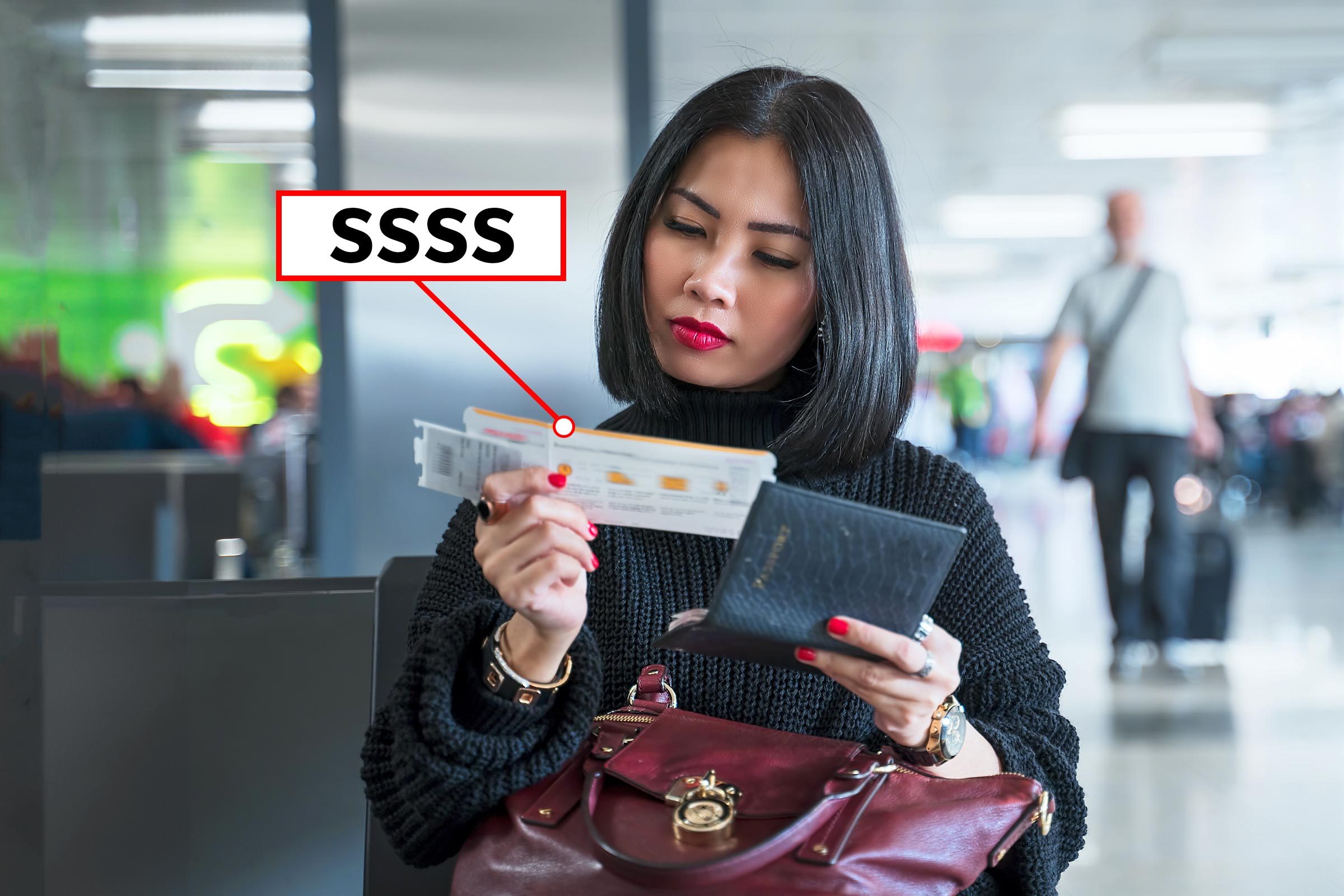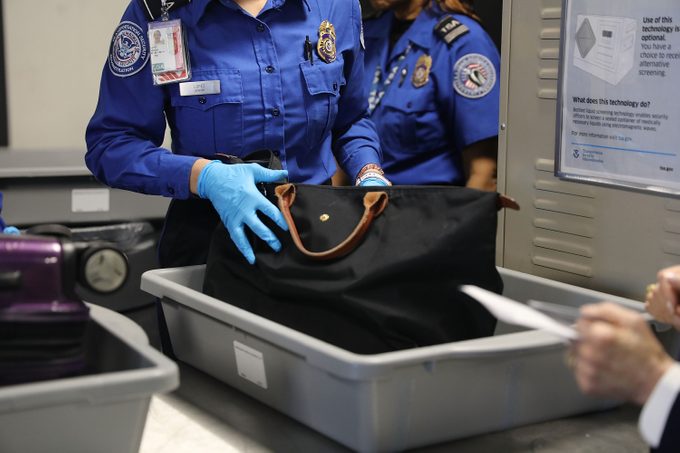What's that mysterious "SSSS" on your boarding pass? A TSA expert reveals what those four letters mean and how to navigate this airport security situation.

What Does “SSSS” on Your Boarding Pass Mean?

You’re standing among the bustling chaos of an airport terminal. The nerves and excitement for your next travel destination are palpable. You crane your neck to get a better look at the line approaching the security checkpoint. You’re not too worried—the airport wait times don’t seem bad. But as you approach the stern-faced TSA agent at the front of the line, you notice you’re carrying an ominous “SSSS” boarding pass, a sudden hiccup in your travel journey.
What happens next? What do those four letters mean, and how did they get on your boarding pass? We talked to both the TSA and a frequent flier who’s been repeatedly tagged with the dreaded “SSSS” to find out everything you need to know about navigating this security situation.
Get Reader’s Digest’s Read Up newsletter for more travel, humor, cleaning, tech and fun facts all week long.
What is an “SSSS” boarding pass?
“Secondary Security Screening Selection (SSSS) is added to boarding passes when that traveler has been selected for additional screening procedures,” says R. Carter Langston, press secretary for the Transportation Security Administration (TSA). Sometimes, the designation appears on a boarding pass at random; other times, it’s on your boarding pass because you have somehow triggered a TSA flag for additional screening—even if you don’t know which one.
“The agency incorporates unpredictable security measures, both seen and unseen, to accomplish the transportation-security mission,” says Langston. In other words, the less predictable these airport security flags are, the easier it is for the TSA to protect people in their travels.
You can get an “SSSS” boarding pass for both domestic flights and international ones.
How common is an “SSSS” boarding pass?
The TSA won’t reveal statistics on this security measure, so it’s impossible to know exactly how common it is to receive the “SSSS” code on your boarding card.
Where can you look for “SSSS” on a boarding pass?
You can usually find the “SSSS” designation in the top-left and bottom-right corners of your boarding pass.
Sometimes, you’ll get an early clue that you’ve been selected: You’ll find yourself unable to check in online. When you get to the airport and check in there, you’ll find the “SSSS” on your boarding pass.
Why do you get “SSSS” on your boarding pass?
There are multiple reasons you might see “SSSS” turn up on your boarding pass, but for security reasons, the TSA is intentionally vague about what might trigger the designation.
We do have some clues from the agency, though. The TSA works with intelligence and law enforcement agencies to share information and flag any individuals who could pose a security threat. If your name—or a name similar to yours—appears on a security list, you may be selected for extra screening. You might also be selected if you purchase your plane ticket at the last minute, if you purchase only a one-way flight or if you have recently traveled to a country that the United States considers high risk.
But the TSA chooses some travelers for the extra screening completely at random. Frequent flyer and international traveler Wendy Thiessen has gotten the dreaded “SSSS” boarding pass multiple times. “I asked the person conducting the secondary screening why I always seem to be the chosen one in our family, and they were kind enough to explain that it was a random security check,” says Thiessen. “I actually felt so much better knowing it wasn’t just me looking suspicious or something more nefarious. It’s nothing you did or how you look—it’s random.”
Can pre-screening programs help you avoid an “SSSS” boarding pass?
Nope, enrolling in a pre-screening program—such as Clear, NEXUS, Global Entry or TSA Pre-Check—won’t prevent the “SSSS” on your boarding pass. Security measures are designed to override these programs, so being on these pre-approved lists does not keep you from being selected for additional screening.
What can you expect if you have “SSSS” on your boarding pass?

In addition to asking you to step through the typical airport body scanner or metal detector, the TSA may swab your hands and carry-on items for explosive residue. Agents may also open your baggage to ensure you’re following TSA carry-on rules.
“They [tested] everything for bomb powder residue and [did] a quick check of carry-on items,” says Thiessen, describing her personal experience. “I have never been taken to a mysterious room or anything worrisome. Friends and family [may] be able to see the person while the secondary inspection is conducted, but they should be prepared to meet their party at the gate or further from the inspection area.”
In some situations, the TSA may select you for a pat-down screening. The purpose of this procedure is to check for concealed prohibited items or security threats. The TSA will inform you about the security check beforehand, and an officer of the same gender will conduct your pat-down, using the backs of their hands over sensitive areas (in rare cases, they may use the front of their hand for added screening).
What can you do if you keep getting “SSSS” on your boarding pass?
Once you have a boarding card with “SSSS,” you cannot bypass the additional screening prior to boarding your plane.
Travelers who are consistently selected for additional security screenings and believe they are unfairly selected can apply to the Travel Redress program, more formally referred to as the DHS Traveler Redress Inquiry Program, or DHS TRIP. Apply online and check the status of your application through the DHS TRIP portal. But remember: This program is designed for future trips and does not affect current trips with an “SSSS” boarding pass.
How can you prepare for additional TSA screenings?
Since you won’t know in advance that you’ve been selected for additional screening, it’s hard to prepare. But there are some things you can do to reduce the stress if it does happen.
Make sure you always leave extra time when flying. That way, if you do get an “SSSS” designation on your boarding pass, you won’t have to worry about missing your plane as you comply with the additional screenings. It can help to check the average waiting times at your departure airport and be aware of the airports with the longest wait times.
Because the inspectors will be opening your bags and examining what’s inside, give some thought to how you pack your carry-on. Having everything neatly compartmentalized will make the inspection easier and therefore quicker. You might also want to consider investing in packing cubes to avoid the embarrassment of having your socks and underwear strewn across the inspection table!
Above all, make sure to cooperate fully with the TSA agents doing the inspecting. It will speed up the process and make sure you get where you’re going.
About the experts
|
Why trust us
At Reader’s Digest, we’re committed to producing high-quality content by writers with expertise and experience in their field in consultation with relevant, qualified experts. We rely on reputable primary sources, including government and professional organizations and academic institutions as well as our writers’ personal experiences where appropriate. We verify all facts and data, back them with credible sourcing and revisit them over time to ensure they remain accurate and up to date. For this piece on the “SSSS” boarding pass, Brianna Bell tapped her experience as a longtime travel journalist to ensure that all information is accurate and offers the best possible advice to readers. Read more about our team, our contributors and our editorial policies.
Sources:
- TSA: “Security Screening”
- Ask TSA: “What to expect during pat-down screening”
- TSA: “DHS Traveler Redress Inquiry Program”
- Department of Homeland Security: “DHS Traveler Redress Inquiry Program (DHS TRIP)”























